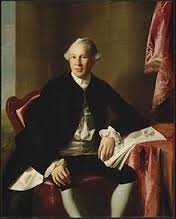
Warren, Joseph, Major General and
Deputy, Grand Master Massachusetts 1769
by George A. Weeks

The first Knight Templar to yield up his life in the Battle of Bunker Hill was Major General Joseph Warren. To give a complete history of General Warren in a few paragraphs is impossible. I will endeavor to give a fair picture.
He was born in Roxbury, Massachusetts, in 1741 and died in the Battle of Bunker Hill in 1775. He was educated in the schools of Boston and Harvard College in medicine and began practice in Boston in 1763. He was an ardent leader in the Revolution and dispatched the riders, Sir Knight Paul Revere and William Dawes, to alarm the countrymen prior to the battle of Lexington and Concord.
His Masonic record is as follows: he was made a Mason in St. Andrews Lodge of Boston; he received his First Degree on September 10, 1761, Second Degree on November 2, 1761, and was made a Master Mason on November 28, 1765. He was elected Master in 1769. He was made a Templar in St. Andrews Royal Arch Lodge of Boston, now St. Andrew's Royal Arch Chapter, May 14, 1770. In December 1769, Sir Knight Warren received a commission from the Grand Lodge of Scotland making him Grand Master of Masons in Boston and one hundred miles around. On March 7, 1772, he received another commission making him Grand Master of Masons for the con tinent of America.
Warren's military record shows he was appointed a Major General, but he had very little military experience. His headquarters were established in Cambridge where he and his staff were trying to drill and equip a citizens' army to fight the British trained soldiers. A meeting was held proposing to fortify the heights of Charlestown; this movement was advocated by the veterans Putnam and Prescott. Warren disagreed, claiming the loss of life would be too great owing to their lack of training and equipment. There were at that time only 11 barrels of powder in the army and but 37 barrels in the entire state. He was overruled, however, in the Council.
On the evening of the 16th of June, a little before sunset, 1,200 troops under the veteran Prescott were issued a blanket and provisions for 24 hours, the privates not even knowing their destination. At 9 o'clock they started their march to Charlestown where they were joined by the veteran General Putnam. Under cover of darkness they started to dig their entrenchments and prepare defenses for the siege on the morrow. On that evening Warren was presiding over a session of Congress in Watertown and did not arrive at headquarters in Cambridge until after daylight where he retired for a much needed rest, having a severe headache.
When he received word of what was to take place, he arose, put on his citizen's clothes, mounted his horse, and rode to Charlestown. There he was recognized by Putnam, who exclaimed, "General Warren, is it you? I will take your orders." Warren replied, "I have no orders to give. I am here as a volunteer to learn the art of war. Give me a musket and put me where the fighting is the thickest and hardest, " He was sent to a redoubt where Colonel Prescott was in command.
Prescott wished to turn his command over to Warren, but Warren refused and took his post as a private. During the battle when the order to retreat was sounded he stood his post, even after the British had entered his entrenchment. A British officer recognized him, called on him to surrender in order to save his life. As he turned to see who had spo ken to him, a bullet struck him in the forehead, and he died instantly.
In times buried Warren exceeded our Grand Master Hiram (who was thrice buried). Warren was buried four times: first, June 17, 1775, on the field of battle. Immediately after the evacuation of Boston, his Masonic Brethren went in search of the body of their Grand Master. On April 6, 1776, they found the body buried in a shallow grave on the brow of the hill, and near the head of the grave was an acacia tree; the body upon removal was identified by his teeth and other distinguish ing marks; his body was borne to the State House, Boston. On April 8 an oration was delivered by Perez Morton, Grand Marshal of the Grand Lodge; the body was buried in the Minot tomb in the Granary burying ground. In 1825, the body was removed to the Warren Tomb, under St. Paul's Church; on August 3, 1855, it was removed to Forest Hills Cemetery, the final resting place.
Although General Warren was termed a Revolutionist, he was fighting for the principles upon which our order is founded: freedom, liberty, justice, and the Christian religion.
Editor's Note: June 14 is Flag Day. Fly Old Glory with Pride!
Taken from: Masonic Americana, 1975...Valiant Templar...
Published 080514 Updated: August 5, 2014